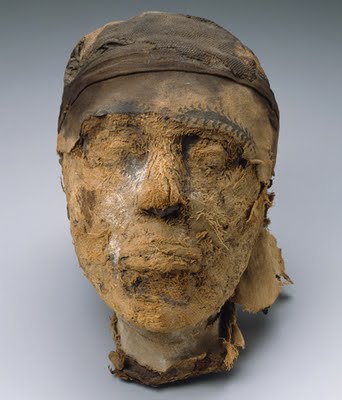Annals of MFA science

“Through the years, scholars have tried to determine if the mummified head found in Tomb 10A was that of Governor Djehutynakht or Lady Djehutynakht. They also would like to know the cause of death and how old he/she was at time of death. DNA tests are currently being conducted on a molar recently extracted from the head by doctors from Massachusetts General Hospital, who sent it to [New York] medical examiners in an attempt to solve this mystery.” – Boston Museum of Fine Arts, 2009.The MFA’s evolving interpretations of the artifacts and human remains that Harvard and MFA archaeologists found in a rocky cliff tomb at Deir el-Bersha, Egypt, in 1915 are a fascinating lesson in the advances of science and archeological interpretation – as well as their limits. And one has to admire the MFA’s showmanship, as the DNA results are expected to come back during the run of the exhibit, and certainly generate a new round of publicity.
“A male head found on top of the coffin of the nomarch probably belonged to Djehuty-nakht himself. … X-ray evidence indicating that this is a male skull includes the well-developed vascular groves on the inner surface of the skull; the large, well-developed sinuses (especially the frontal); the very large and developed mastoid air cells; as well as the rugged architecture of the skull, with its strong square jaw.” – catalogue to the MFA’s 1988 exhibit “Mummies & Magic: The Funerary Arts of Ancient Egypt,” p. 111-112.
“Secrets of the Tomb 10A: Egypt 2000 BC,” Museum of Fine Arts, 465 Huntington Ave., Boston, October 18, 2009, to May 16, 2010.
Pictured: “Head of the mummy of Djehutynakht,” Egyptian, Middle Kingdom, late Dynasty 11 – early Dynasty 12, 2010–1961 B.C. Human remains, linen. Museum of Fine Arts, Boston. Harvard University—Boston Museum of Fine Arts Expedition. Photograph © Museum of Fine Arts, Boston.






0 Comments:
Post a Comment
<< Home